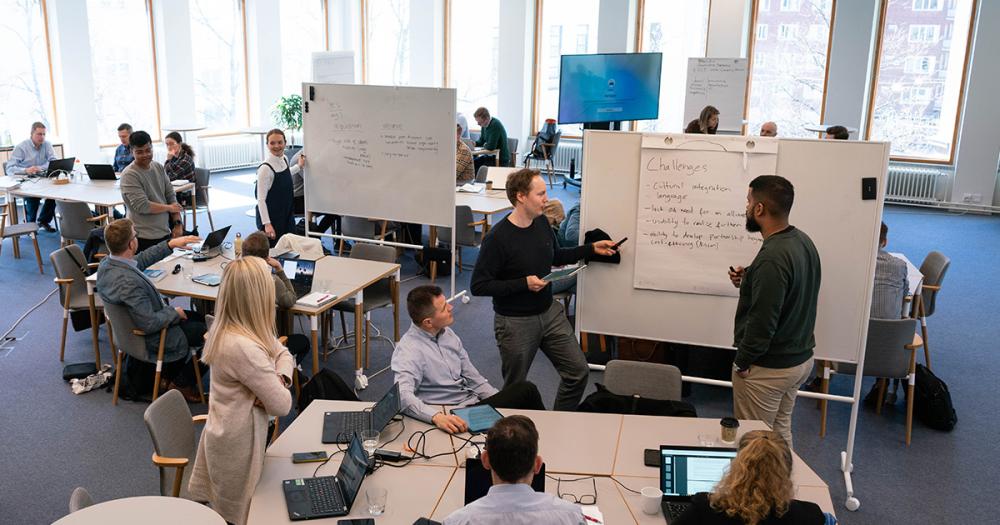Information Visualization
Online Course
Make Sense of Data
Today more than ever, we are living in a very visual environment. At the same time, our world is filled with data derived from observations of different phenomena. By visualizing this information, we can make better sense of the data. We can visualize connections, similarities, patterns, and groups of related things; thus, we can better understand the world around us and make informed decisions on complex issues.
Through the Information Visualization online course, you will become familiar with the must-know, should-know, and nice-to-know issues for visualizing information. The course gives a self-directed student a concise understanding of what information visualization is, why it is needed, and how to get started. It helps you to initiate visualization and prompts you to carry out your chosen task with expert advice.
As well as studying the online materials, you are expected to choose a visualization challenge and apply the lessons learned to it. However, if making visualizations yourself is out of the scope of your interest, you can limit your study to the lessons and gain a comprehensive overview of the topic. After taking the course, you will understand the benefits of visualizing data for memorizing, decision-making, and learning, know the basics of visual storytelling, and you have explored a range of visualization examples. You will also be able to identify typical problems in information visualization and how to overcome them. Finally, you will have an idea of advanced methods for visualizing and the psychology of seeing and understanding visualizations.
|
By completing the course, you will get an Aalto EE Information Visualization certificate worth 1.5 ECTS. |
Working at your own pace, gain a clear overview of information visualization
The focus is on how to make quantitative data understandable and usable
Understand the skills needed to argue and impact with your data
Benefits
Every day, we are confronted with data that aims to impact us in many ways. Understanding how information can be visualized helps us make sense of the data and recognize the underlying facts. This course gives you the understanding and tools to start creating intelligible and impactful visualizations. You will gain a clear overview of information visualization and understand the role and potential of data in creating information visualizations.
For
If you need to understand and learn to decipher visualizations and what is behind them, then this course is for you. If you want to prepare visualizations of your own, this course will get you started. The course is designed for those who want a concise overview of what information visualization is about. It focuses on making quantitative data understandable and usable. You may need to understand and learn to decipher visualizations and what is behind them, or you may want to prepare visualizations of your own.
Visualizing information is beneficial when
- your task is to make research results intelligible for investors,
- you need to make statistics live and compelling,
- you are aiming to recognize and highlight anomalies in large amounts of data, or
- you need to make sense of complex data for your board members.
Contents and Schedule
We encourage an exploratory and self-directed mindset! This online course is structured into ten online modules. The modules consist of videos and podcasts, reflection tasks, and practical assignments. The modules are followed by interactive questions to check your knowledge along the way. An integral part of your learning will be employing a course workbook for practice, reflection, and later reference. The workbook includes reflection prompts and gives you expert directions on how to advance a visualization project of your own.
The estimated time of study is five days. Each of the videos and podcasts is approximately ten minutes long. But watching and listening are only part of the story! We urge you to watch and listen to the material more than once to enable learning. First, you may like to do it at a faster pace. Maybe you like to take a walk while listening to a podcast? Make sure to take breaks to make notes and immerse yourself in your workbook and your visualization challenge. Also, explore the suggested examples and additional resources. However, if making visualizations yourself is out of the scope of your interest, you can limit your study to the lessons and gain a comprehensive overview of the topic.
The course videos are subtitled in English.
Course structure
Ten Online Modules
Videos, podcasts, and narrated visualizations, each approximately 10 min
Knowledge Check
Check your lessons learned
Workbook
Follow expert directions to start your visualization
Modules
Module 1:
Course Introduction: What is Information Visualization?
Module 2:
Elements of Visual Storytelling
Module 3:
Data Universe
Module 4:
Design Principles for Visualizations
Module 5:
Trends and Future of Information Visualizations
Module 6:
Psychology of Visualizing Information
Module 7:
Purposes of Visualizations: Who Makes Visualizations and Why
Module 8:
Basic Methods of Visualizing Information
Module 9:
Explanatory and Exploratory Visualizations
Module 10:
Visualizations for Society and the Skills to Create Them
The Course Workbook
For reflection and reference, the online course includes a workbook to support your learning during and after the course. Employing the workbook is an integral part of your learning process.
The workbook includes reflection prompts and offers you directions on how to advance your visualization project. Download it onto your computer. Choose any file format you wish for doing your work, Word, PPT, Miro, Mural, and so on. Augment the workbook further with content relevant to you and find examples of visualizations in the media and on the internet. Explore and practice the topics discussed in the modules, make notes and gather useful material and links to suit your needs.
If you would like to receive feedback for your work from faculty and peers, you may like to continue your studies and join our Information Visualization Hands-on program.
Instructor

Tomi Kauppinen
Tomi Kauppinen is the head of Aalto Online Learning at Aalto University. His background is in media technology and computer science. He aspires to bring an entrepreneurial mindset and lean and agile creativity to all his projects and teaching.
Tomi Kauppinen is Head of Aalto Online Learning at Aalto University. He holds a habilitation (2014) in geoinformatics from the University of Muenster in Germany and the title of docent (2014), a Ph.D. (2010) in media technology from Aalto University, and an M.Sc. (2004) in computer science from the University of Helsinki. Kauppinen's passion is to create, study, and teach information visualization, spatial thinking, cognitive systems/artificial intelligence, and blended learning design. Since 2016, he has led the Aalto University-wide strategic development initiative, Aalto Online Learning, which covers activities ranging from blended learning to fully online textbooks and exercises, from video production to online social interaction, from artificial intelligence-based recommendations and assessment to interactive visual simulations, and from augmented/virtual reality to games and gamification. With his background in startups before a calling to academia, he aspires to bring an entrepreneurial mindset and lean and agile creativity to all his projects and teaching.
























